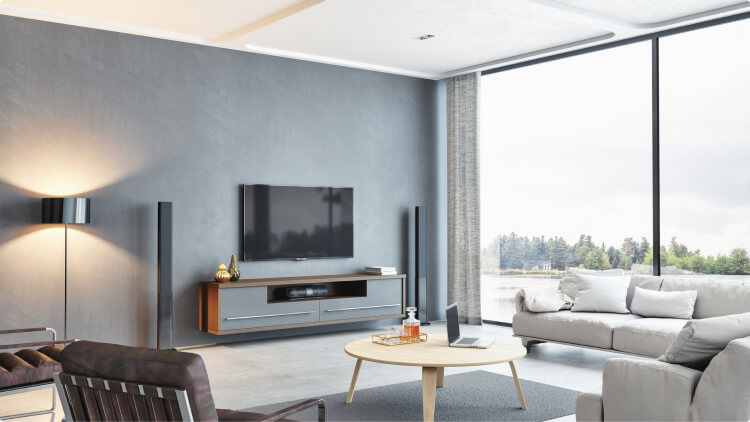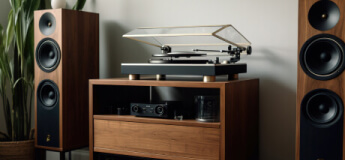The Evolution of Home Theater Rooms
Discover how multipurpose rooms are becoming the trend
Please rotate your device
Landscape mode is not supported. Please return to portrait mode for a better experience.
(Or, better yet, download our app from the APP Store!)
Discover how multipurpose rooms are becoming the trend
As the home technology market continues to evolve, more homeowners are putting their AV in other rooms where they can do a variety of activities rather than traditional theater spaces.
In recent years as technology has improved, advances in home theater technology are allowing homeowners to think about their homes in ways that weren't possible before.
New technologies that include laser and Ultra Short-Throw (UST) projection, miniLED, microLED, the latest generations of LED and OLED displays are facilitating the placement of large screens due to their brightness in rooms that traditionally were not ideal environments, especially where lighting control is challenging.
Meanwhile, on the audio side, wireless surround-sound solutions and immersive platforms such as Dolby Atmos and DTS:X are producing more engaging sonics to accompany movies, TV shows, live-action sports, gaming and more.
Obviously, dedicated home theaters will never go away, but the frequency of these types of system installation may never match the pace of what the industry experienced in late 1990s and early 2000s. Fortunately, as the market has evolved from dedicated theaters to modern multipurpose systems. Today's new systems deliver arguably the highest levels of performance ever seen in the home through an emphasis on room design, acoustics, premium components and system calibration.
Another benefit of today's theater and multipurpose rooms is that in many cases custom integrators are enlisting interior designers and architects to offer homeowners a much more integrated solution that complements their entire living space and overall home décor.
Below, professional systems integrators share their thoughts on the evolution of home theater: Paul Diggin of Advanced Communication Technologies, Derrick Potts of Simplifi and Andy Worshill of Haas Home Entertainment.
Diggin says that he and his team have wrestled with the relevancy of the term home theater, and he admits that most of the systems his company installs are in multipurpose spaces.
“Right now, I have a large, dedicated home theater project that I'm working on. But I might only do one a year. It is less than we did 10 or 15 years ago. Back then it seemed like we did maybe a half dozen a year”, he says.
“Now, we might have another handful of rooms that are really multipurpose. [Clients] use them for movie watching. They use them for gaming. It might be part of a bigger room that has a bar in it, a pool table, or a foosball table.”

Diggin notes that customers who do want dedicated theaters are using them for applications such as gaming and sports, so they are getting more usage than the dedicated systems of the past, which were mainly used for movie viewing.
Helping to spur value beyond the flexibility of modern systems is how well new technologies complement today's lifestyles, according to Diggin. He points out that the growth of the market also offers integrators many more product choices. This enables his company to specify and install systems that include large-screen displays, which now commonly go from 65- to 85-inch sets, in place of a projector to provide an immersive experience in spaces that in previously weren't hospitable to big screens.
“Sometimes when you don't have a room that's right for a projector, you could go with a really nice display that gives a really good picture, and you can get [homeowners] a large one without breaking the bank,” Diggin asserts.
“You can also provide really nice audio with all of the formats out there, and the calibrations you can do to support those formats to ensure their quality. I think you can kind of take some rooms that aren't always perfect and still make them sound really good. So, I find us doing that a lot.”
Serving the Kansas City market, Derrick Potts, owner of Simplifi, and the rest of his team have been shifting to more general entertainment spaces.
“The literal term for us in the Midwest is 'dedicated theater,' and we've been using that term for the past year or two,” states Potts. “Most of our installs, however, are multipurpose rooms.”
Potts states that one of the major reasons for that is the nature of home design in the Midwest, where many homes employ open floor plans, and are commonly used by homeowners for a range of activities. Those include gaming, bars that serve adult beverages and comfortable seating like sofas to lounge in while enjoying AV systems that provide the latest features.
The types of spaces are not closed in rooms with tiered seating, Potts explains, adding that his company's projection sales have slipped with the company installing more large-screen televisions.
“New technologies have helped to drive multipurpose systems. LED TVs and short-throw projectors offer great pictures with placement on credenzas, and they have helped to increase our multipurpose AV system installations,” he comments.
“All of those technologies have helped dress up our installations. Samsung Smart Frames allow us to install stylish systems. Dressing up the media is important for us, and it is as important as high-quality AV. Sometimes clients will ask for a high-tech look with multiple displays. I think that as the technologies improve and the prices drop, solutions like OLED and microLED will push people to do a lot more AV in multipurpose home environments.”
- Derrick Potts, owner of Simplifi, serving the Kansas City market

Related Resource
Learn how ADI can meet all of your Pro AV needs
Potts says that Simplifi uses a mix of products from some of the top brands in the custom installation industry.
“Broad stroking, a good majority of our homes have multiple TVs that are wall mounted. Our installations also include whole-house audio,” he points out.
“The TVs we use will be Sony and Samsung, and control will vary depending on whether the client is asking for partial or fully automated homes. We also use Roku and Apple TV, and we use the smart features built into the televisions. If they ask for automation, we'll include a remote and solutions from Lutron or Crestron. We do a lot of shading from Lutron and a lot of lighting from Lutron too. We will also do surveillance with cameras and depending on the installation control with apps — sometimes it will be a single app that includes everything and sometimes customers will want control with multiple apps.”
Andy Worshill, operations manager of Haas Home Entertainment, says there is still room in the modern home technology market for the dedicated home theater.
“I don't think it is time to retire the term 'home theater' from dedicated theater to theater. In fact, I think that both the term 'dedicated theater' and so much more can peacefully coexist,” offers Worshill. “I would say that compared to 10 years ago, the demand for dedicated home theaters isn't what it used to be, but we still do a handful of dedicated theaters throughout the year.”
Worshill estimates the company installs three to four of them per year. Like his East Coast and Midwest colleagues, he says that most of the company's AV installations do fall under the umbrella of multipurpose systems that include loudspeakers, subwoofers, and large displays such as OLEDs.
More advanced systems will feature products such as a high-performance projector and separate amplifiers and processors.
Worshill states that one interesting development the integration firm is seeing is the impact of dedicated home theaters on home values. While it is too early to draw a conclusive opinion, he notes, in Southern California the trend is for owners to request multipurpose AV systems.


Get to know AVARRO's audio and video solutions
In those spaces, Haas Home Entertainment typically will specify 85-inch TVs, along with feature-rich AV receivers. Worshill adds that when the company addresses smart home technologies and services, it offers customers everything from environmental controls such as lighting/shading and climate to security. Another technology that has also become crucial in today's era are smart 4K TVs.
“Everything starts with the network… a router from Access Networks with access points for Wi-Fi,” Worshill says of the enterprise-grade provider.
“Homeowners will get some favorites [remote control buttons in the system] to play their favorite music, and that is usually fine with clients. As far as TVs, we are agnostic. If a customer has a preference, we'll use that brand. But, for a proper media room such as a living room, family room or master bedroom, we will use a Sony LED TV and MartinLogan speakers for those that want a quality listening area, as well as background listening.”
Additionally, he says Haas Home Entertainment is seeing growing demand for lighting fixtures, as well as smart home amenities like thermostats, surveillance cameras, and access control solutions.

Choose the right projector for your next commercial or residential AV installation with our in-depth guide and support services from ADI.
Learn More
Learn how ADI can meet all of your Pro AV needs, with an extensive selection of products, as well as services to help you at every stage of the process.
Learn More
Learn everything you need to know to choose the right speakers for your next residential and commercial project.
Learn More